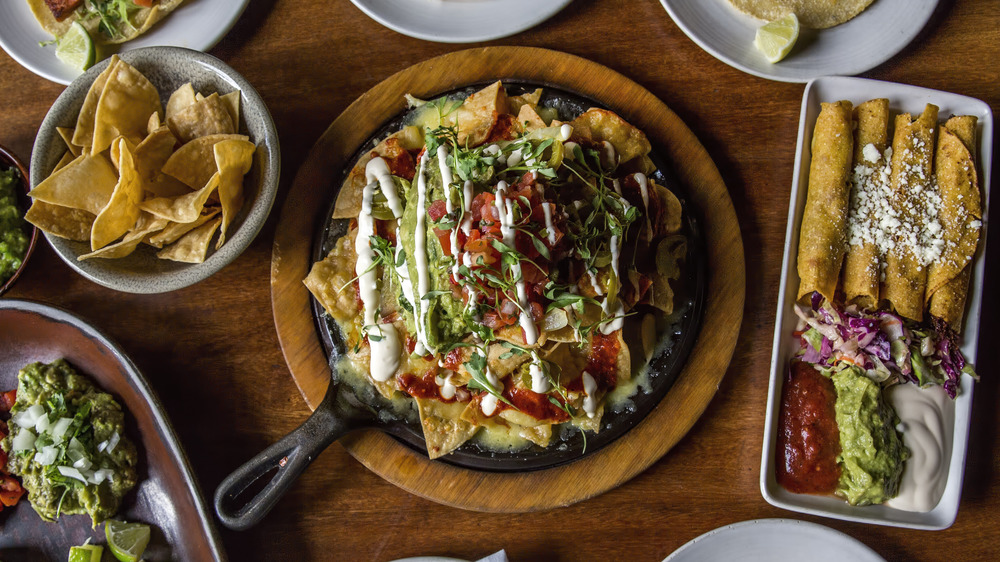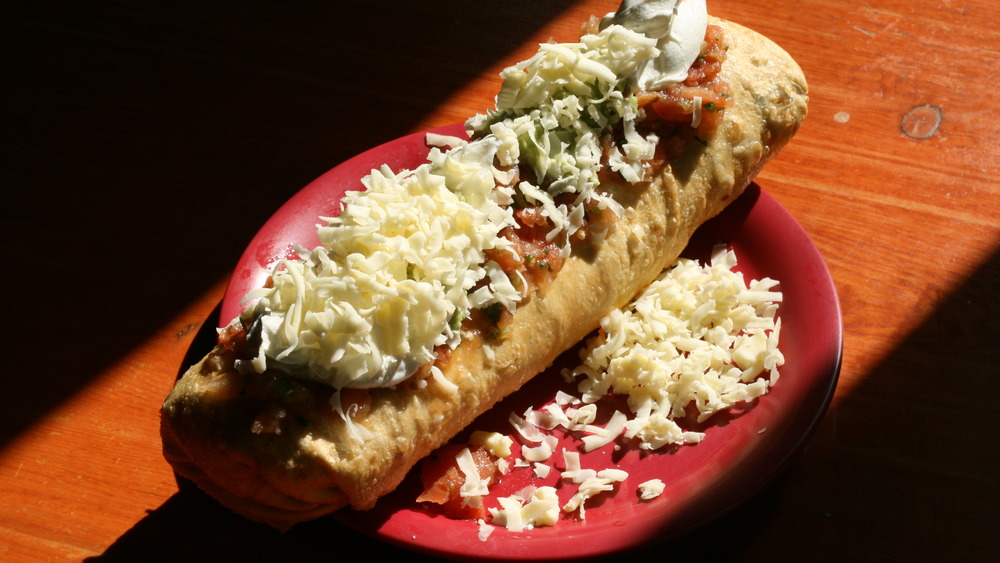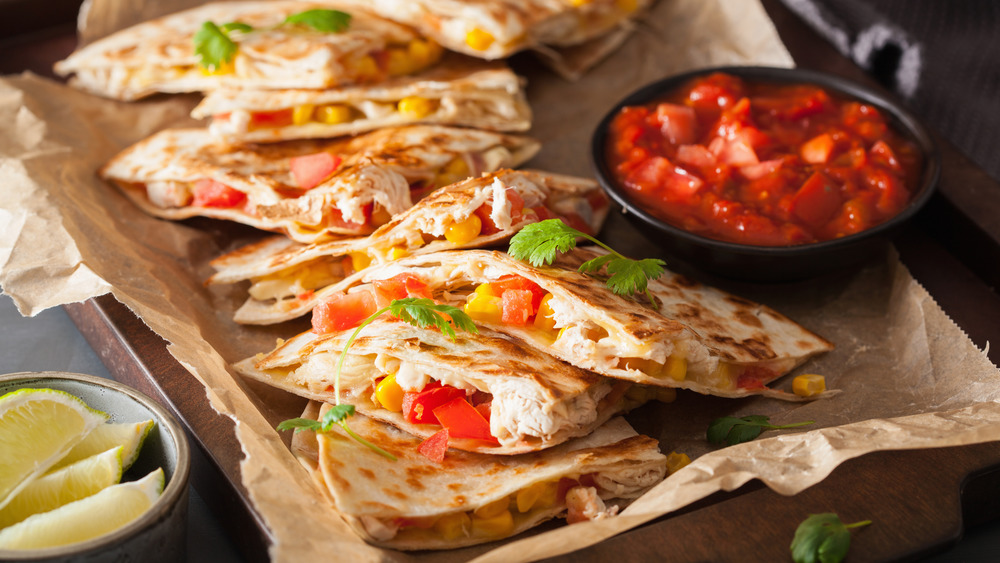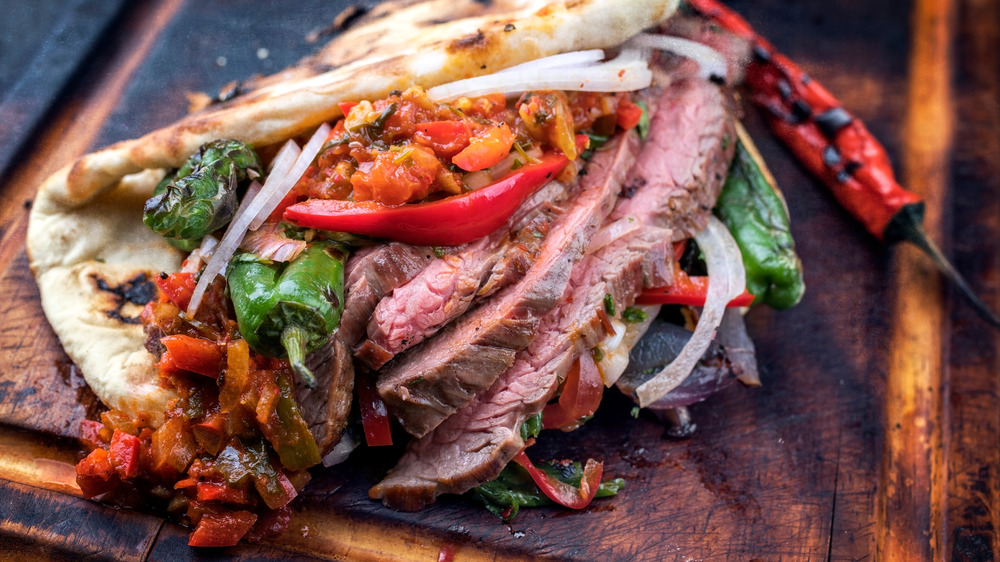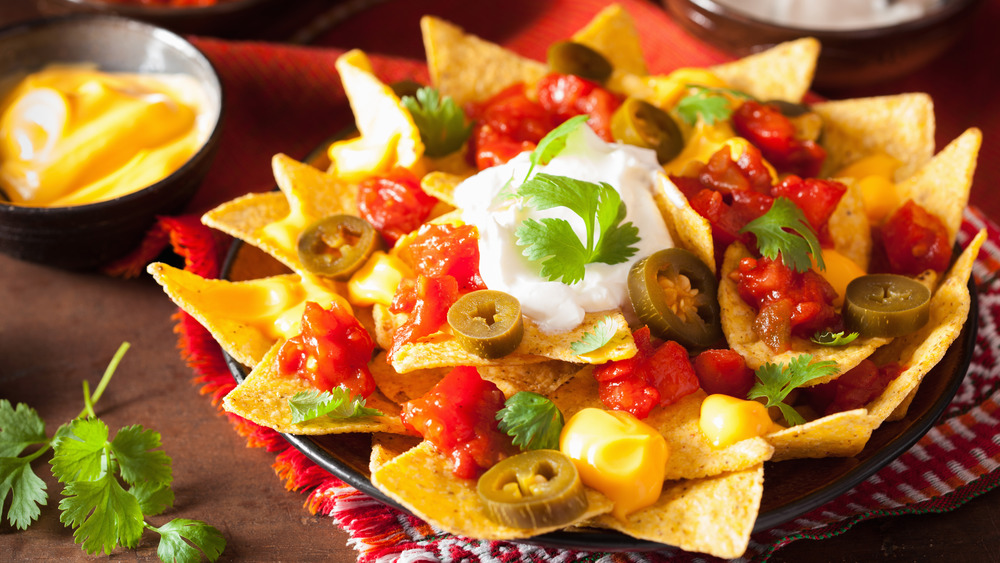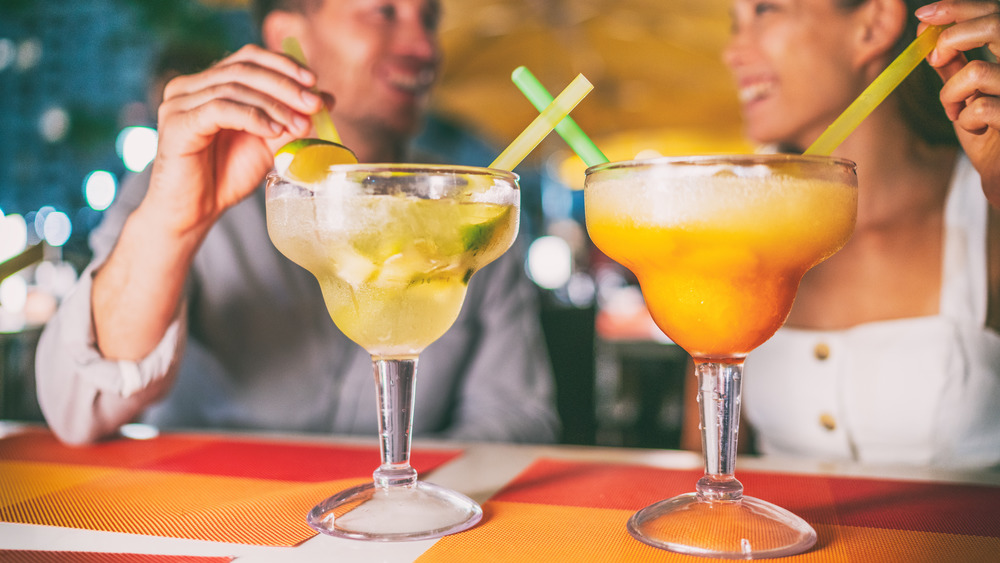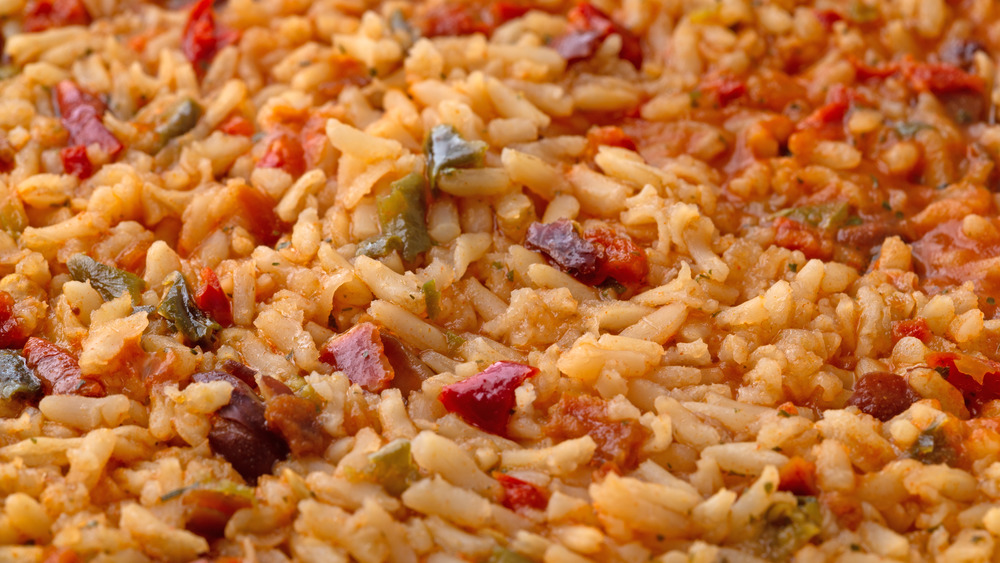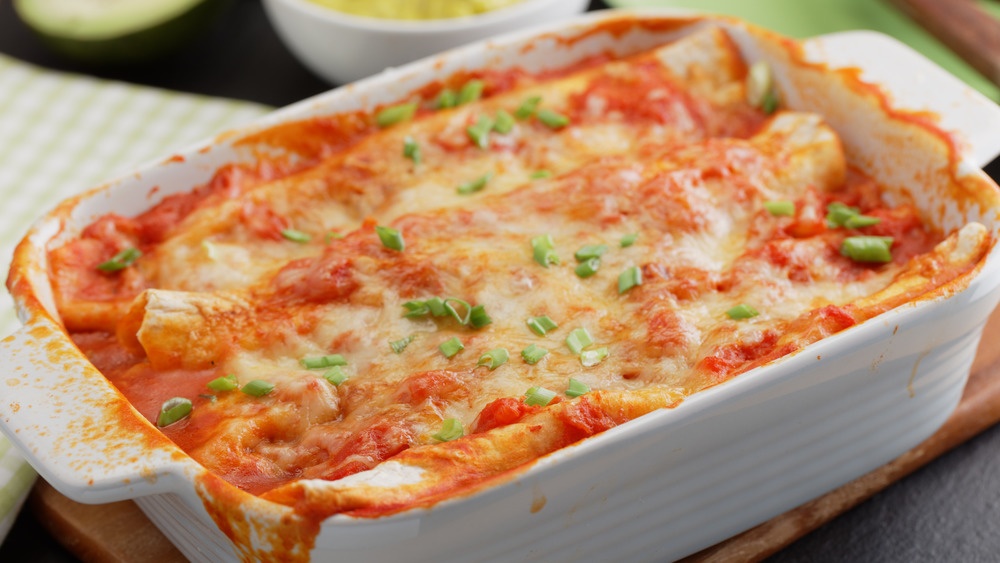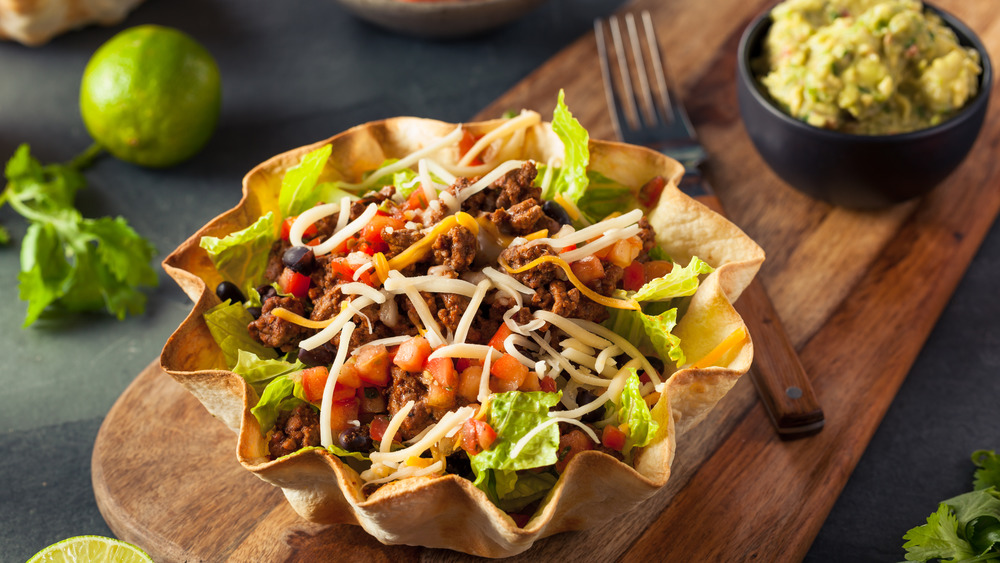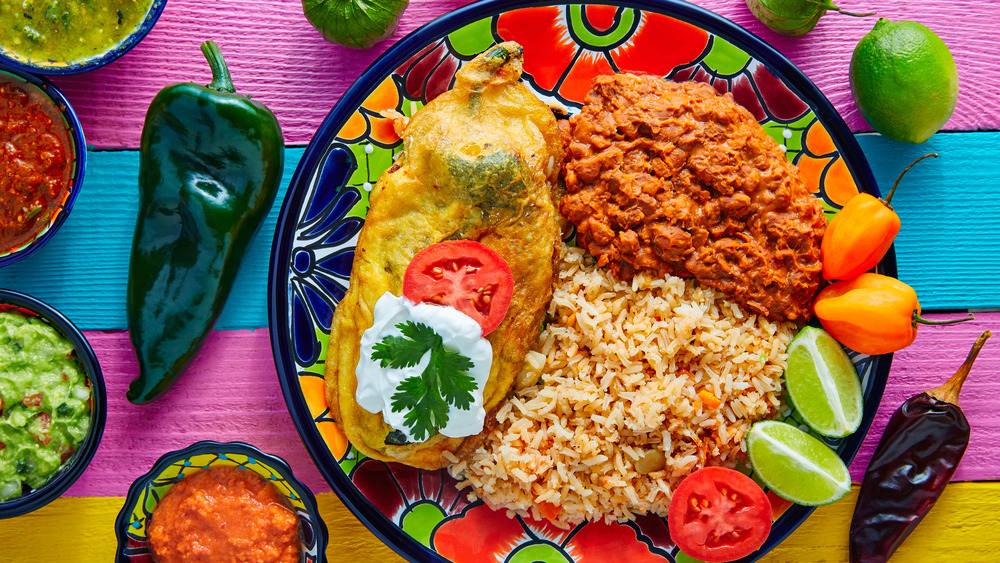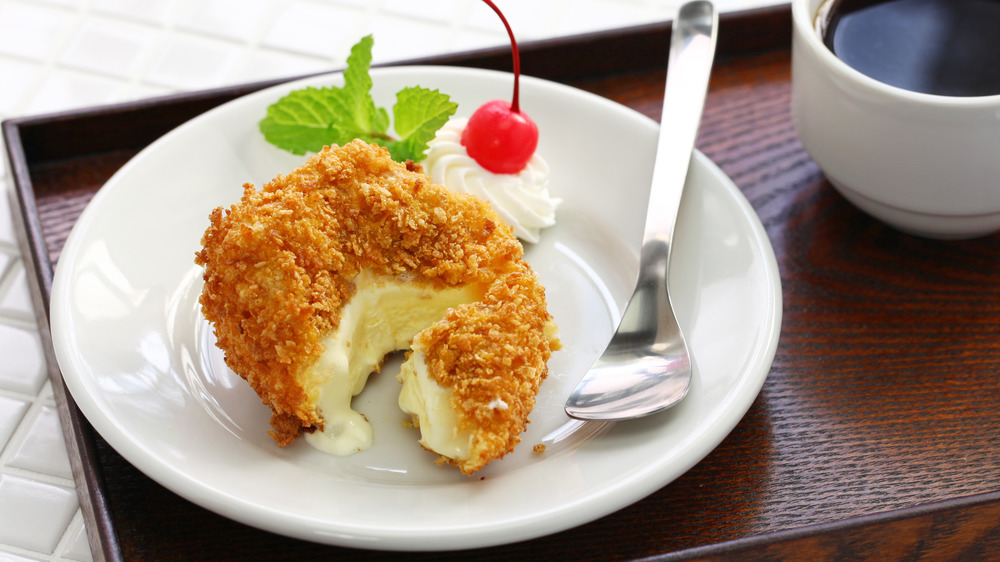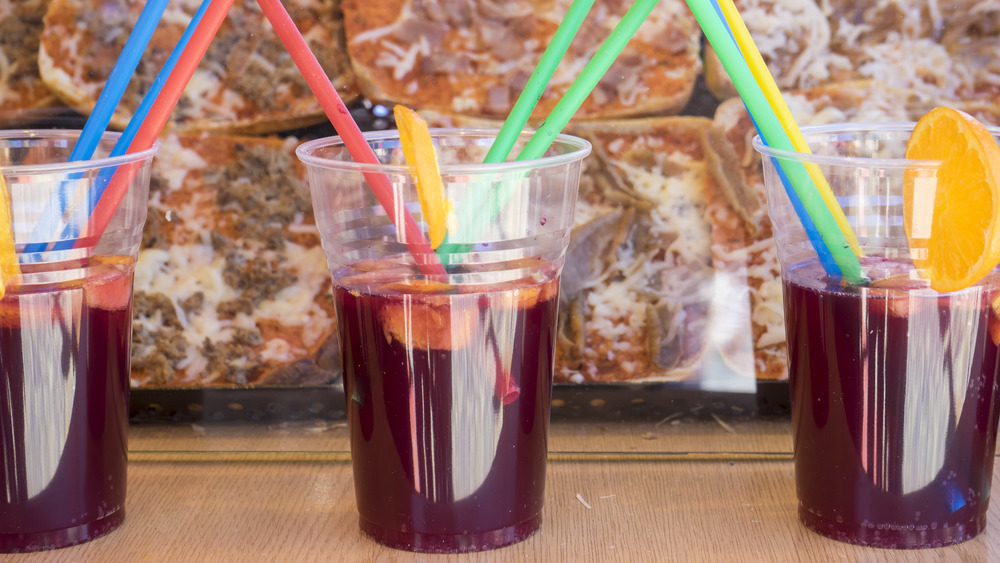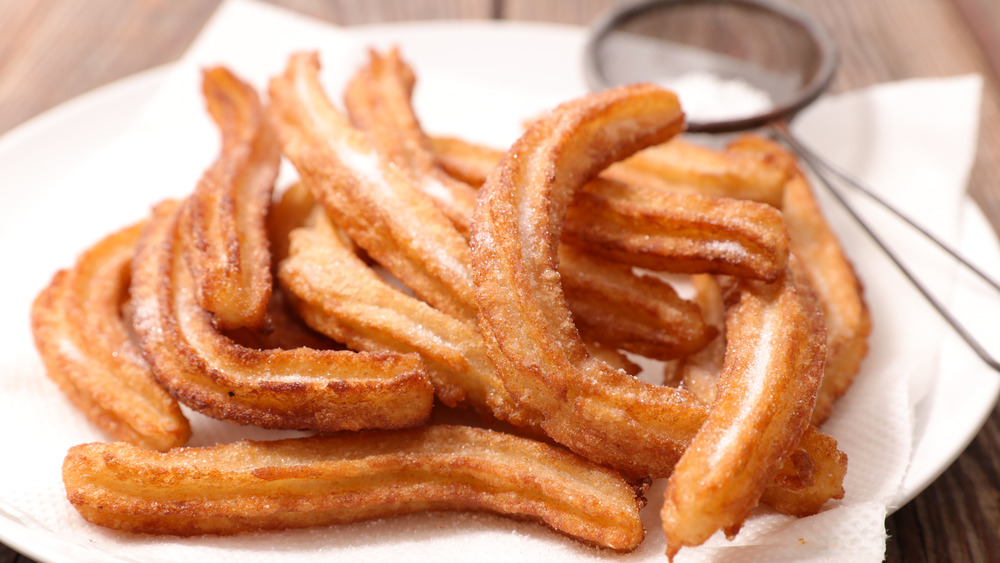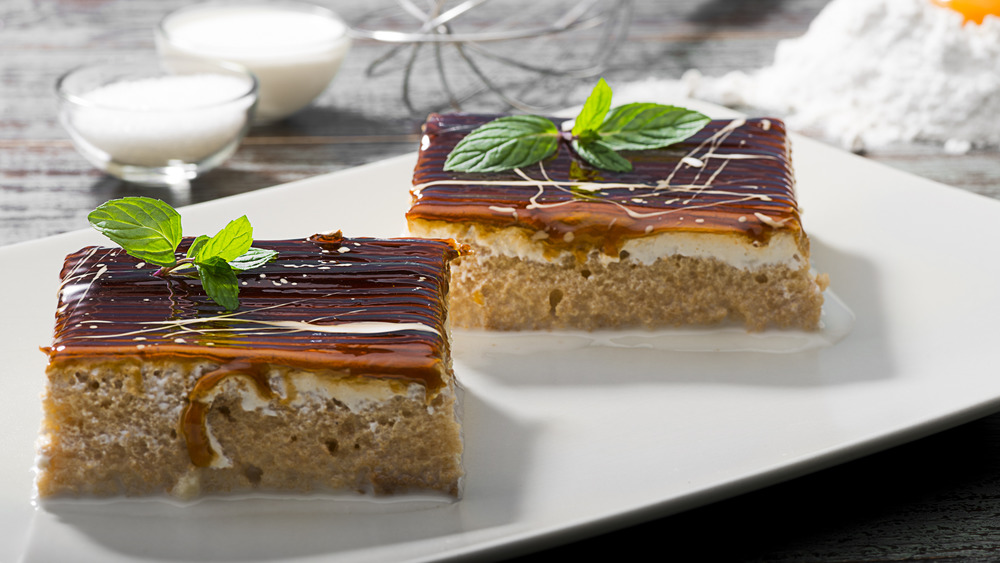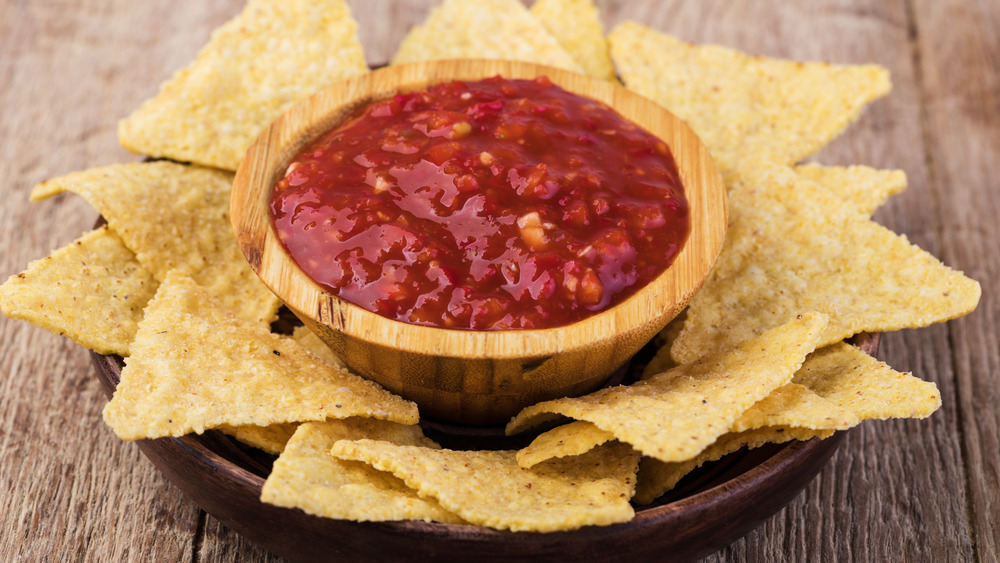Unhealthy Food You Should Always Avoid At Mexican Restaurants
America's appetite for Mexican food is insatiable. According to Abasto, the industry leading tracker of news for hispanic food and beverage entrepreneurs, consumption of Mexican food and cuisine continues to grow in the U.S., both in grocery stores and in restaurants. The group estimated that there were approximately 60,000 Mexican restaurants in the country by fall 2017 — that's about 9 percent of the entire restaurant industry.
All of the ample and available Mexican food means two things: We have numerous options to pick from when deciding what we want to eat and, since Mexican food can also be loaded with fatty meats and cheeses and sauces, it means there's also plenty of not so healthy Mexican food out there that we all need to steer clear of. We're talking appetizers and entrees with double or even triple the calories and fat you'd find in other foods on the exact same menu.
How do you know what's good and what's bad when your South-of-the-border craving strikes? You can start by banishing the foods that follow from your standing go-to orders. All are high calorie, sparse in nutrients, and the epitome of unhealthy.
One of the fattiest foods you can order at your favorite Tex-Mex joint is the chimichanga
The chimichanga, or the chimi as they're lovingly known in the Southwest, is essentially a deep-fried burrito. Once packed with a hearty filling — which may include beef, chicken, or pork plus cheese, beans, peppers, chiles, and spices — chimichangas are dropped in a fryer filled with oil and cooked until they reach crispy perfection. If that weren't delicious enough, chefs generally add even more cheese plus toppings such as green onions, diced tomatoes, guacamole, sour cream and black olives before serving.
Even though they're scrumptious, nutritionist Carrie Madormo explained in an article for Taste of Home that chimichangas are one of the most unhealthy dishes you can order at a Mexican restaurant. "Chimichangas are high in calories, saturated fat and trans fats," she warned, adding that the American Heart Association cautions against a diet high in these fats because they can significantly increase risk for diabetes, high blood pressure and obesity.
According to CalorieKing, a single chimichanga contains 810 calories, 48 grams of protein, 57 grams of carbohydrates, and 43 grams of fat. That's approximately the same amount of fat as you'd get by eating half a stick of butter.
Quesadillas are a no-go when ordering from your favorite Mexican restaurant
In Mexico, the word "quesadilla" roughly translates to "little cheesy pastry," according to The Daily Meal. And that's a fairly accurate description. Chefs craft quesadillas using corn or flour tortillas. After that, anything goes. The quesadilla can be filled with multiple cheeses, grilled meats, caramelized peppers and onions, or virtually any other food you'd find floating around a Mexican kitchen.
The beauty of the quesadilla is the ease of preparation. The tortilla is heated on a hot grill, filling is added to one half of the warm shell, and then the other half is folded over, sealing everything inside. As with most Mexican dishes, it's then smothered with additional goodness in the form of extra cheese, sour cream, and salsa. Sounds delicious right?
The issue with quesadillas, according to WebMD, is the way they're typically cooked and prepared in restaurants. Heaping piles of meat and cheese are sandwiched between giant flour tortillas, and then everything is pan-fried and topped with even more fatty condiments. The USDA estimates that one large cheese quesadilla contains 714 calories, 31 grams of protein, 47 grams of carbs, and 45 grams of fat (via Livestrong).
Fajitas loaded with all the toppings can be a calorie bomb
The humble fajita has a long and storied past. According to the Austin Chronicle, the classic meal of beef, tortillas, and ample fixings dates back to the 1930s when Mexican cowboys were paid, in part, with strips of skirt steak. When work was done for the day, they'd gather around the campfire and cook the meat in sizzling cast iron pots in portions large enough to feed their group.
Livestrong cautions that even though the ingredients in modern-day fajitas tend to be healthy, the portion sizes are usually out of control. This means you need to be careful when ordering. At Applebee's, for example, an order of steak fajitas can contain 1,560 calories, 69 grams of protein, 119 grams of carbs, and 90 grams of fat.
To keep fajitas lean when ordering, go easy on the tortillas and opt for salsa and veggies over sour cream and guac. Or just make them at home. "I would never order fajitas at a restaurant," Saul Montiel, executive chef at Cantina Rooftop in New York, told Insider. "They're really nothing more than sautéed onions and peppers with a protein. Nothing exciting."
They may be ooey gooey and delicious, but nachos should be given a hard pass
Considering how simple they appear, you might think nachos date back centuries. But according to Time, the dish was actually created in 1943 by Ignacio "Nacho" Anaya. One day, a group of about a dozen women came into Ignacio's restaurant as it was closing. Taking pity on his hungry customers, he decided to stay open and feed them using the food he had left in his kitchen. He sliced and fried tortillas and topped the resulting chips with cheese and jalapeños. When he served the dish, he named it after himself using his nickname: Nachos Especiales. And with that, nachos were born.
Just as when Anaya dreamed up the dish, nachos are designed to feed a crowd so portions are always too big. Plus, with toppings that include greasy meat, high-calorie refried beans, multiple varieties of cheese plus sour cream or aioli, there's nothing nutritionally redeeming, cautioned nutritionist Bonnie Taub-Dix to NBC News. A typical serving of nachos at a restaurant like Chili's can pack 1,540 calories, 109 grams of protein, 53 grams of carbs, and 99 grams of fat. And that's for an appetizer!
If you're eating healthy, frozen margaritas aren't on the menu
Surprisingly, there was a time when tequila wasn't popular in America. In fact, it wasn't until prohibition was passed in the 1920s that industrious citizens living along the Mexico border started crossing over into our neighbor to the south and began smuggling back the local liquor (via The Atlantic).
Margaritas are the obvious cocktail of choice when it comes to using tequila. They're tasty, refreshing, and easy to make — typically just tequila, lime juice, and triple sec. If you stick to traditional margarita recipes, the drinks aren't so unhealthy. The problem with margaritas in most Mexican restaurants is that they use margarita mix, which is basically all sugar in the form of high fructose corn syrup. Steer clear of frozen margaritas especially, nutritionist Frances Largeman-Roth told Everyday Health, because they're pre-made and you can't ask for any substitutions.
Besides being loaded with sugar, the portion sizes for margaritas at some restaurants are enormous with some glasses containing almost as much as a pitcher. Livestrong estimates that a 16-ounce jumbo frozen margarita can contain a whopping 448 calories, most of which come directly from sugar.
Steer clear of high-calorie sides when ordering at your favorite Mexican joint
Refried beans and rice are staples of Mexican cooking — and for good reason. They're nutrient dense, affordable, and delicious. Chef Gabriela Cámara provided her traditional recipe for refried beans to Masterclass and, not surprisingly, the recipe contains beans, garlic, onion, spices — and plenty of lard. That's the standard way the dish is prepared at most restaurants. WebMD has advised against ordering refried beans, warning that a single serving can carry about 10 grams of fat. They also pack a whole lot of salt.
A massive side of rice next to your burrito is no better an option. In fact, research shows that eating it too often can increase your risk of obesity. A study published in the Journal of the Academy of Nutrition and Dietetics followed 10,000 people over four years and found that individuals who ate white rice regularly were more likely to be overweight than individuals who didn't. Rice in Mexican dishes is also typically fried in oil, bringing a cup of the stuff up to approximately 380 calories and nearly 11 grams of fat per serving (via Eat This, Not That).
Say adios to those savory smothered enchiladas
Like a burrito, enchiladas consist of fried tortillas wrapped around ground beef, pork, or chicken plus cheese and refried beans. Enchiladas also tend to be a bit more elaborate and "fancy" compared to their burrito brethren. Texas Monthly has reported that in order to be considered an enchilada, the tortillas also need to be doused with a sauce made from tomatoes, herbs, and various chili peppers before baking. That sauce is actually where the dish gets its name: in Spanish the word "enchilar" literally means "to season with chile."
That hearty sauce and filling is also what typically makes enchiladas so high in calories. According to FitDay, "Fast food or commercially prepared enchiladas can be calorically dense, high in sodium, high in saturated fat and limited in vitamins and minerals." Although it's possible to make leaner versions of enchiladas at home, the site warned that enchiladas served in restaurants are filled with too much meat, over-topped with cheese and paired with bountiful and unneeded sides. All together, the site estimated a typical enchilada meal can set you back more than 1,000 calories.
It may sound lean, but taco salad is deceptively unhealthy
Of all the menu items you can order in a Mexican restaurant, taco salads sound like they should be one of the most nutritious options available. But in reality, taco salads are far from the healthiest thing on Mexican restaurant menus. For starters, Livestrong reported that a single fried taco salad shell can contain nearly 400 calories on its own. Add the ground beef, cheese, and sour cream, and you've got a "salad" that can clock in at more than 1,000 calories.
This isn't a new problem based on growing portion sizes for meals either. In a landmark study conducted more than two decades ago that still holds up today, the Center for Science in the Public Interest (CSPI) sent samples of different Mexican dishes from different restaurants all over the country to an independent lab for nutritional analysis. CSPI said you'd have to order the salad without the beef, cheese, guacamole, sour cream, and fried tortilla shell to make it healthier. What's left? "A bowl full of lettuce," said Bonnie Liebman, the group's then director of nutrition (via The Washington Post).
Chile rellenos pack an alarming number of calories and fat
After analyzing different restaurant samples of chile rellenos served at various restaurants across the country, researchers working for the Center for Science in the Public Interest (CSPI) declared the dish the Mexican equivalent of fettuccine alfredo (via The Washington Post). Most restaurant-style servings of chile rellenos are overly salted, too creamy, and exceptionally greasy, with the same saturated fat content as 27 slices of bacon, the CSPI found.
How does a dish that is essentially based around a low-calorie vegetable boast so much fat? Blame it on the preparation. The peppers are stuffed with cheese, coated in batter, deep-fried, and then topped with even more melted cheese.
If you insist on having chile rellenos, make a lighter version at home. Oxygen has recommended filling peppers with the healthy filling of your choice (diced onion, corn, and diced zucchini are ideal), dipping them in egg, and coating in breadcrumbs. Then, instead of frying the finished pepper, bake it in the oven for a few minutes or until golden brown.
Give fried ice cream the cold shoulder
The origins of fried ice cream are relatively murky. While it isn't thought to have originated in Mexico, it became a Mexican restaurant staple when the popular chain Chi-Chi's put the dessert on the menu.
The recipe for Chi-Chi's frozen ice cream reads like a how-to manual on making something unhealthy. You start with super sweet ice cream that is formed into balls and rolled in cinnamon and sugar. The ice cream is then rolled in crumbled corn flakes. The resulting coated ice cream balls are re-frozen until hard and then placed in a fryer filled with hot cooking oil and cooked for several seconds. The cooked, breaded ice cream balls are then covered with whipped cream and honey and served with strips of sugar-coated tortillas.
Calorie counts for the dessert vary based on the type of ice cream used, but FitBit estimates that an average serving contains 810 calories, 161 grams of carbs, and 16 grams of fat. To put the calories in context, that's about the equivalent of drinking 6 cans of Coke.
Opt for a white wine spritzer instead of ordering the sangria
Technically, sangria is Spanish, not Mexican. Still, the refreshing blend of red wine and fruit juice figures prominently on the menus of countless Mexican restaurants. Traditionally, sangria contains a mixture of chopped fruit along with red wine. Liquors, such as brandy, as well as fruit juice, sugar, and a mixer like soda or lemonade, are also added to the mix. The one thing all those ingredients have in common is that they all contain sugar.
The USDA reports that an 8-ounce serving of sangria made with red wine, added liquor, club soda, sugar, and lemon juice contains 219 calories and 16 grams of sugar — making it twice as sweet, ounce for ounce, as sweetened soda (via Livestrong).
Because sangria can vary so much from location to location, most experts recommend avoiding it entirely. In its stead, nutritionists suggest sticking with red or white wine, which has around 125 calories per glass (via Healthline). Or, if you're looking for something similarly refreshing, opt for a red or white wine spritzer (made with wine and club soda only) instead. Both are light and bubbly, like sangria, and taste similar, minus all those added sugars.
If you're thinking about dessert, don't go for the churros
Cultures all over the world have their own unique dessert take on sweet fried dough. In America, it's doughnuts; in Mexico, it's the churro. As the Los Angeles Times reported, churros are essentially "a batter essentially consisting of water, flour, eggs, sugar and a pinch of salt that is piped through a pastry bag into long strips, deep-fried in vegetable oil, then rolled in cinnamon mixed with sugar."
As you might expect from something with such a basic list of ingredients, there's not a lot of nutrients to gain when you eat a churro. You're basically just getting sugar and fat. "If you're looking for a nutritional powerhouse, this isn't it," nutritionist Joan Carter told the publication. "It's a fun food."
Nutritionally speaking, a standard churro like those you'd get from a typical to-go restaurant comes in at around 280 calories per serving, with 39 carbs and 11 grams of fat —about the same as what you'd get in a standard candy bar. But you could argue that candy bars are more nutritious than churros since they typically contain chocolate and nuts.
Tres leches cake is delicious yet wildly unhealthy
Like the British trifle, Caribbean rum cake, and Italian tiramisu, tres leches cake is a cake that's been soaked with a liquid to make it extra moist, tender, and incredibly flavorful (via What's Cooking America). In this case, that liquid is actually three different types of milk — whole milk, evaporated milk, and sweetened condensed milk — poured over a basic sponge cake. This makes sense given the name; Tres leches translates to "three milks."
Obviously, just looking at the sheer amount of rich dairy involved in making tres leches cake, you know it's going to be unhealthy. According to Calorie King, tres leches cake contains 220 calories, 31 grams of carbs, and 10 grams of fat per 2.8 ounces — and this is just a very small portion. Even for just that amount, you'd need to jog or cycle vigorously for nearly a half-hour to burn off those extra calories.
If you do nothing else, avoid the free tortilla chips when eating at a Mexican restaurant
Everybody's happy to see the basket of free tortilla chips show up when dining at a Mexican restaurant. But each one of those chips packs about 20 calories. Knowing that, consider just how many you mindlessly scarf down as you ponder your order, enjoy a drink, and chat with your dining companions. According to Eat This, Not That, the free chip basket is "one of the quickest ways to pile on calories before your main course ever hits the table."
Another reason to avoid this high calorie restaurant trap? The chips you're devouring are not usually that good — you're just eating them because they're there, and they're free. "Most restaurant tortilla chips taste like printer paper seasoned with cardboard shavings," opined Thrillist. They're overly salty, greasy, and usually have an odd aftertaste.
Need yet another reason to just say no? Some restaurants have also been known to "reuse" their chips, moving bowls that "look" like they haven't been touched from table to table until they finally get eaten. And that's not just unhealthy, it's flat out nauseating.

